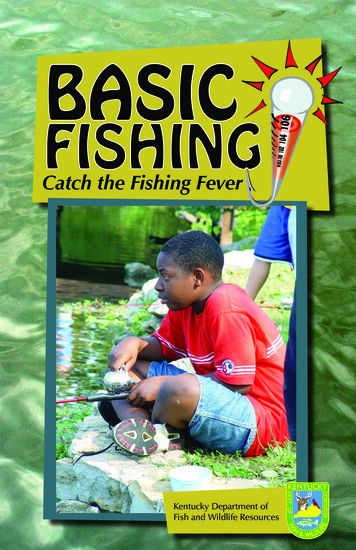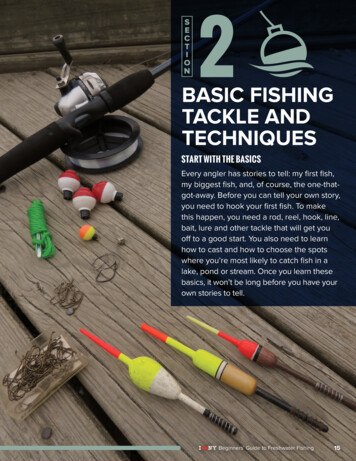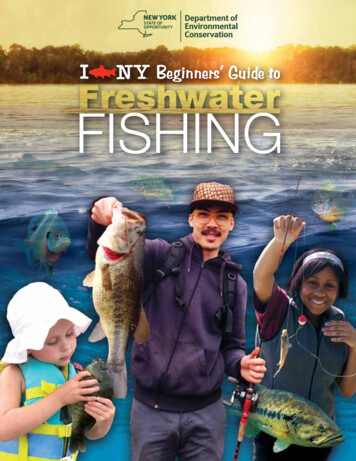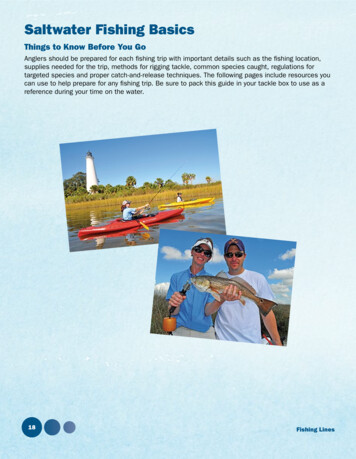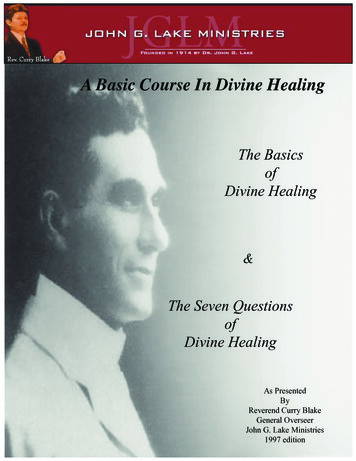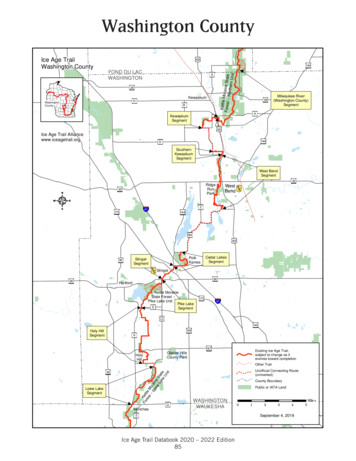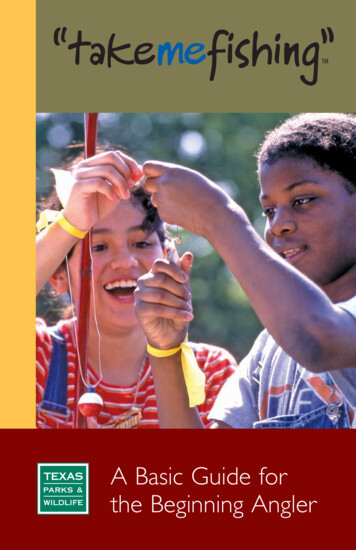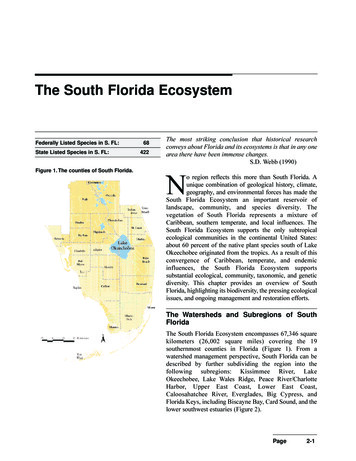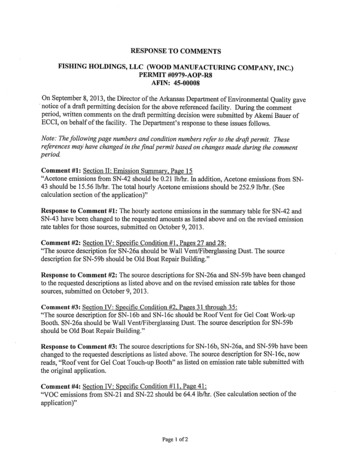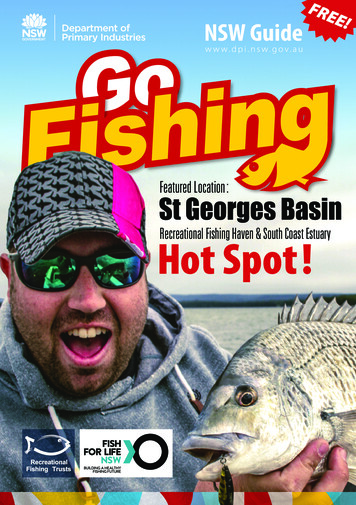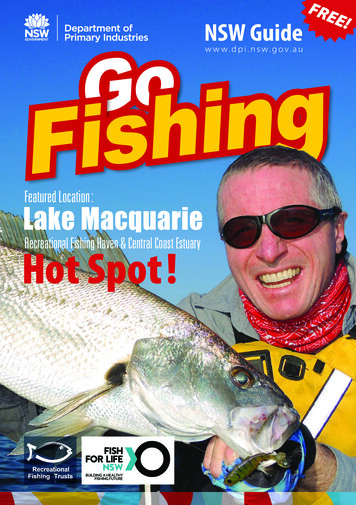
Transcription
GoNSW GuidegnihsiFFeatured Location :Recreational Fishing Haven & Central Coast Estuary
Message from the MinisterThrowing a line at a new spot always makes fora great fishing adventure. Whether you’re juststarting out or an expert fisher, NSW boastssome of the best locations to fish in the world.In addition to being one of the state’s favouriteactivities, recreational fishing is a massivecontributor to our economy. It’s a 3.4 billionindustry and generates 14,000 full-time jobsacross the state.ContentsOverview3Location MapFact Box: ArtificialReefs In Lake Macquarie4Key Target Species6Other Species9Handy Knots9Catch & Release Info510The NSW Government knows how importantrecreational fishing is and has developed arange of programs to enhance angler accessand opportunities. This series of guides topopular fishing locations is a great exampleof the proactive approach by the NSWGovernment to promote recreational fishing.We’re fortunate to live in NSW where there areso many great places to fish. I hope these DPIguides help you have a safe and productivefishing experience around our great state.Tight lines!The Hon. Adam Marshall, MPMinister for Agricultureand Western New South WalesCOVER IMAGE: Mark Williams. P3 and P7 images: Mark Williams. Fish Illustrations: Pat Tully. All other images: NSW DPI.JTN 16379 12/2019.This fishing location guide is produced by the NSW Department of Primary Industries (NSW DPI) LMB 3020 Nowra NSW 2541, for and on the behalf of the state of New South Wales. This guide isproduced using funds from the Recreational Fishing Trust as part of our commitment to providing recreational fishers with comprehensive, user-friendly information. State of New South Wales through Department of Planning, Industry and Environment [2019].DisclaimersThis publication may provide assistance or information but NSW DPI and its employees do not guarantee the publication is without flaw or is wholly appropriate for any particular purpose and thereforedisclaims all liability for any error, loss or other consequence which may arise from relying on any information in this publication. This publication is a guide only, it does not replace the Fisheries ManagementAct 1994 or other acts and statutory rules applying to or affecting recreational fishing. It is a summary of laws and regulations at the time of publication and cannot be used as a defence in a court of law.Recreational fishing regulations may change during the lifetime of this publication. It is the responsibility of fishers to ensure they are acting within the law at all times. Check regulations with your localNSW DPI fisheries office or www.dpi.nsw.gov.au/fisheries.The product trade names in this publication are supplied on the understanding that no preference between equivalent products is intended and that the inclusion of a product name does not implyendorsement by the department over any equivalent product from another manufacturer.No material matter in this publication may be reproduced, stored in a retrieval system, or transmitted in any form by electronic or mechanical means, photocopying or recording without the written permissionof NSW DPI.2GO FISHING – LAKE MACQUARIE
OverviewSydneyLake Macquarie is a Recreational Fishing Haven located on the Central Coastnear Newcastle, about an hour’s drive north of Sydney. The Lake has a surfacearea of about 110 sq km, making it the largest coastal saltwater lake in Australia.It’s home to a wide range of popular recreational fish species includingmulloway, bream, dusky flathead, tailor, squid, luderick, sand whiting, yellowtailkingfish and Australian salmon.Fringed by a number of picturesque towns and villages including Swansea,Belmont, Mannering Park, Wangi Wangi and Toronto, Lake Macquarie featuresnumerous sheltered bays, headlands and creeks. It’s an extremely productiveand popular fishery for locals and for visitors from other areas with plenty ofholiday accommodation, caravan parks and camping grounds.Lake Macquarie is linked to the sea via Swansea Channel on the eastern side.This waterway is tremendously popular with recreational anglers targeting duskyflathead, bream, whiting and luderick. Large schools of Australian salmon oftentake up residence in the channel during the cooler months, providing greatsport for anglers using lures or fly tackle. Yellowtail kingfish are a prized catch foranglers fishing with surface lures or live baits around Swansea Bridge or at thenearby “Drop Over” where the channel meets the Lake. Three larger creeks (DoraCreek, Cockle Creek and Stoney Creek) drain into the Lake as well as a number ofsmaller waterways, many of which are popular fishing locations.Popular with land-based and boat/kayak anglers, Lake Macquarie offers yearround estuary sportfishing access in calm and protected waters.As well as being a Recreational Fishing Area, the Lake has a series of DPI artificialreefs, constructed using funds from the Recreational Fishing Trust. These reefsprovide valuable habitat for key recreational fishing species and additionalfishing opportunities for local and visiting anglers.GO FISHING – LAKE MACQUARIE3
Lake Macquarie
FACT BOXARTIFICIAL REEFS INLAKE MACQUARIEA total of 180 specially designed artificial reef modules, known as “reef balls”, weredeployed by DPI Fisheries in six locations along the 5m depth contour off Galgabba Pointin December 2005. Each of the locations is about 180m apart, covering a total distance ofabout 900m. The Lake Macquarie artificial reef system was increased in size in 2009 withan additional 480 modules installed across the site. These new modules are considerablylarger (each weighing between 200kg to 700kg per module) than the initial reefballs. Research indicates the reefs were quickly colonised by fish, shellfish, sea weed andcrustaceans. Since their deployment, the artificial reefs in Lake Macquarie have becomeextremely popular fishing locations with anglers targeting a range of key recreationalspecies including yellowfin bream, snapper, tarwhine, dusky flathead and silver trevally.The reefs have also produced “prestige” sportfish such as yellowtail kingfish and amberjackas well as a range of bait species.GPS CO-ORDINATES FOR THE REEFS ARE:Lake Macquarie Artificial Reef - 1Co-ordinates: 33 05.604’S, 151 36.612’ELake Macquarie Artificial Reef - 3Co-ordinates: 33 05.764’S, 151 36.790’ELake Macquarie Artificial Reef - 5Co-ordinates: 33 05.880’S, 151 36.879’ELake Macquarie Artificial Reef - 2Co-ordinates: 33 05.680’S, 151 36.738’ELake Macquarie Artificial Reef - 4Co-ordinates: 33 05.814’S, 151 36.891’ELake Macquarie Artificial Reef - 6Co-ordinates: 33 05.985’S, 151 36.942’EGO FISHING – LAKE MACQUARIE5
Key target speciesMullowayPEAK SEASON – October to April.TECHNIQUE – Bait fishing withlive or fresh squid; lure fishing withvibes and soft plastics.TACKLE – 4-6kg spin outfits, 10-15kg braid or mono and 10-15kg leader. When baitfishing, use size 5/0–8/0 non-offset circle hooks on a running sinker rig.Use 9-14 gram jig heads on size 3/0 hooks teamed with 7-10cm “paddle” style tails or softvibes when targeting mulloway on plastics.HOT SPOTS – Drop-offs, deep holes, around bait schools.BAG & SIZE LIMITS – One per day 70cm and over.6GO FISHING – LAKE MACQUARIE
Dusky FlatheadPEAK SEASON – October to April.TECHNIQUE – Bait fishing withwhitebait, fresh prawns or livepoddy mullet; lure casting withsoft plastics, vibes and deep divinghard-bodies.TACKLE – 3-4kg spin outfits, 3-4kg braid or mono line and 4-8kg leader. For bait fishing, use1/0 to 4/0 non-offset circle hooks on a running sinker rig. Try 9 to 14 gram jig heads on 3/0hooks teamed with 6-10cm “paddle tail” or “shad” style plastics in mullet, pink, “black & gold”or prawn type colours. Use a “lift and drop” retrieve. Vibes can be substituted for soft plastics.Diving hard-bodies can be effective around drop-offs and flats.HOT SPOTS – Drop-offs, weed edges, flats systems, creek mouths.BAG & SIZE LIMITS – 10 per day 36cm or over. Only one over 70cm. Anglers are encouragedto practice catch & release on all large flathead to help maintain Lake Macquarie’s stocks intothe future.BreamPEAK SEASON – Year round.TECHNIQUE – Bait fishing with fresh prawns,fish strips and marine worms; lure fishing withsoft plastics, vibes and small hard-bodied divers.TACKLE – 2-4kg spin outfits, 2kg braid or mono and2-5kg leader. For bait fishing, use size 2-1/0 non-offset circlehooks unweighted or with a small running “00” ball sinker. The use of berley is effective whentargeting bream on bait. Use 1-2 gram gram jig heads on size 1-2 hooks teamed with 3-8cm“wriggler” style tails when targeting bream on plastics. Use a slow “lift and drop” technique.HOT SPOTS – Drop-offs, flats, weed beds, artificial reef system.BAG & SIZE LIMITS – 10 per day 25cm and over.WhitingPEAK SEASON – October to April.TECHNIQUE – Bait fishing with live marine worms;surface luring with poppers and small stick baits.TACKLE – 2-4kg spin outfits, 2kg braid or mono and 2-5kg leader. When bait fishing, usesize 1 non-offset circle hooks on a running sinker rig. Cast small surface lures aroundsandflats and shallow weed-beds for exciting top-water action on hard fighting whiting!HOT SPOTS – Flats, shallow weed beds.BAG & SIZE LIMITS – 20 per day 27cm and over.GO FISHING – LAKE MACQUARIE7
LuderickPEAK SEASON – Year round.TECHNIQUE – Bait fishing withgreen weed and occasionally asbycatch when targeting bream orwhiting using marine worms as bait.TACKLE – 3-4kg spin outfits generally using longer 3m slow action rods. Standardluderick rigs incorporate a stem float weighted by split shot terminating in a size6-8 sneck hook baited with strands of green weed. Some anglers are having successusing artificial “weed flies” in place of weed.HOT SPOTS – Edges of weed beds, channels, reefy areas.BAG & SIZE LIMITS – 10 per day 27cm and over.TailorPEAK SEASON – Year round.TECHNIQUE – A common bycatch whenbait and lure fishing for bream and flathead.Larger specimens can be targeted by trolling deepdivers along drop-offs and around bait schools.TACKLE – 4-6kg spin outfits with 6kg braid and 6-8kg leaders. A short length of heavymono “bite leader” may be required to avoid bite-offs from the tailor’s sharp teeth.HOT SPOTS – Drop-offs, around bait schools, artificial reefs.BAG & SIZE LIMITS – 10 per day 30cm and over.SquidPEAK SEASON – Year round.TECHNIQUE – Commonly targeted usingsquid jigs. Squid will often attack a live or deadbait used for species such as mulloway and flathead.TACKLE – 2-4kg spin outfits with 3kg braid and 3-4kgleaders. Try an array of squid jigs in different colours andsizes (colours including pink, orange, natural and purplecan be effective).HOT SPOTS – Around shallow sea grass beds and rocky, weedcovered shoreline.BAG LIMIT – 20 per day.8GO FISHING – LAKE MACQUARIE
Other SpeciesA number of other species including garfish, mullet, tarwhine, snapper, flounder andleatherjackets can also be caught in Lake Macquarie’s productive waters. The lake alsooccasionally produces tropical species such as giant herring, big eye trevally, cobiaand even dolphinfish. Native bass are available to adventurous anglers exploring theheadwaters of tributaries running into the western side of the Lake.As well, Lake Macquarie offers great prawning and crabbing during the warmer months.The prawns “run” during the dark of the moon and can be targeted with scoop netsover the shallow sand flats particularly in the vicinity of Swansea Channel. Tasty blueswimmer crabs (as well as the occasional mud crab) are on the cards if you set a hoopnet in deeper water adjacent to a weed bed or mangroves.HANDY KNOTSUNI KNOT – This is an excellent knot for connecting hooks and swivels to the end offishing lines. A very dependable knot. Use more wraps with lighter line, less with heavierline. It can also be used to attach your fishing line to your reel by passing the line aroundthe back of the spool rather than through the eye of the hook.1. Thread line through eye.2. M ake this configuration.3. B egin wrapping loop Cwith tag A.4. Continue wrapping fourto six times.5. Moisten the line andform a knot by pullingtag A against loop C.6. A s you continue topull on the tag all ofthe spirals in the tagare transferred to theloop D.7. This forms a slippingknot and loop.8. The loop C disappearsas the knot slides downon to the eye.GO FISHING – LAKE MACQUARIE9
DOUBLE UNI KNOT – This is a useful knot for joining two lines.1. Overlap the lines to be joinedthen encircle one line with thetag of the other.2. Wrap the double strand insidethe formed loop.3. Make four wraps in all.4. Do the same with the other lineso the knot in each line is tiedaround the other.5. M oisten the line and tighteneach knot in turn.6. Draw the knots together, tightenonce more, then trim the tags.CATCH & RELEASE INFO10Catch & release fishing is becomingincreasingly popular, with many anglersnow electing to release key species suchas flathead, bream, tailor and mulloway.Recent research by NSW DPI has shownthat most fish survive using current C&Rtechniques.nKey ways to release fish successfullyinclude:n U sing non-offset circle hooks andartificial lures.nGO FISHING – LAKE MACQUARIEnnnnUsing suitable tackle to minimise fight times.Using knotless landing nets.I f deeply hooked, cutting the line close tothe mouth.Minimising the fish’s time out of the water.Using wet hands or gloves to handle fish.Reviving the fish upon release.See www.dpi.nsw.gov.au/fisheries for moreinfo on best practice C&R techniques.
Trophy Flathead FisheryRelease Big Flatties!These waters are beingtrialled as a ‘trophyflathead fishery’ toboost stocks andincrease recreationalfishing opportunities.Anglers are encouragedto release all flatheadover 70cm in length.If you catch a tagged flathead,send the tag details togamefish.tagging@dpi.nsw.gov.auw w w.dpi.n s w.gov.a u
vibes and soft plastics. TACKLE – 4-6kg spin outfits, 10-15kg braid or mono and 10-15kg leader. When bait fishing, use size 5/0–8/0 non-offset circle hooks on a running sinker rig. Use 9-14 gram jig heads on size 3/0 hooks teamed with 7-10cm “paddle” style tails or soft vibes
